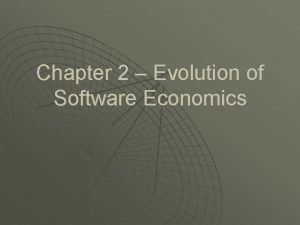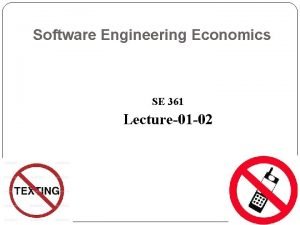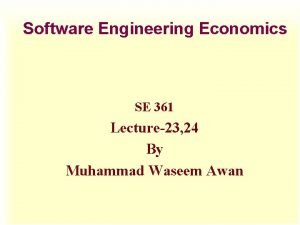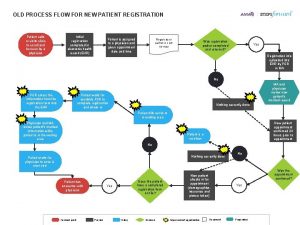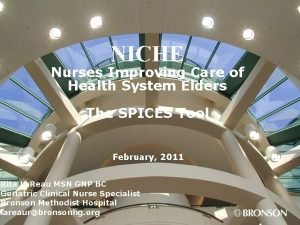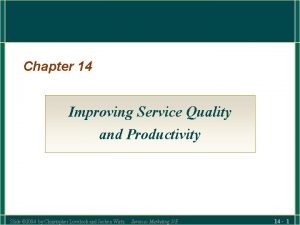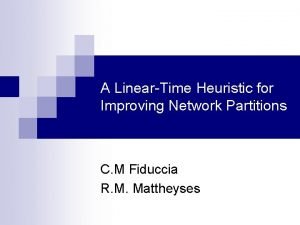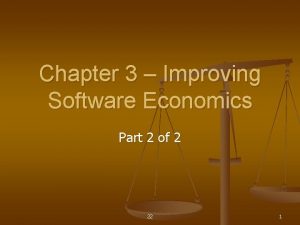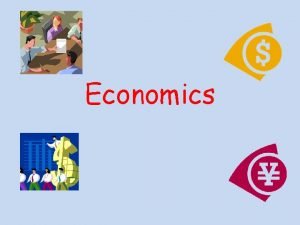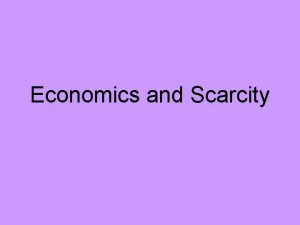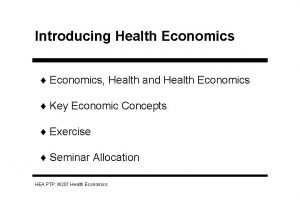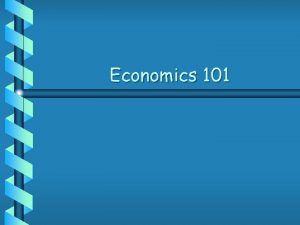Chapter 3 Improving Software Economics Part 1 of























- Slides: 23

Chapter 3 – Improving Software Economics Part 1 of 2 23 1

Balanced Attack u u Can improve software economics Easy to do so and have poor results Key is a ‘balanced’ approach; patient Five Key Initiatives – In Order: • Reducing the size and/or complexity of application • Improving the development process itself • Using more-skilled personnel and creation of better teams • Creating better ‘environments’ with appropriate tools and technology to foster improvement • Re-looking at Quality 23 2

This lecture u We will concentrate on • Reducing the Size (most slides), and a little on • Looking at the Process. 23 3

Cost Model Parameters Trends Size Abstraction and component-based development technologies Process Methods and techniques Personnel People factors Training and personnel skill development Teamwork Win-win cultures Environment Automation technologies and tools Integrated tools (visual modeling, compiler, editors, debuggers, CMS, …. Open Systems Hardware platform performance Automation of coding, documents, testing, analyses Quality Performance, reliability, accuracy Hardware platform performance Demonstration-based assessment Statistical quality control 23 Higher Order Languages (C++, Java, VB, OO (analysis, design, programming) Reuse Commercial Components Iterative Development Process Maturity Models Architecture-first development Acquisition reform 4

Comments on Overall Approaches u u Significant interdependencies are apparent! Examples: • Some tools (environment) can bring about a reduction in size and process improvement (process). • UI and GUIs today (tools – environment) GUI Builders, affect process and quality… • Improved process (use-case driven…) => end user functionality drives the process thus favorably impacting quality…. • A ‘host’ of other interdependencies… 23 5

1. Reducing Software Product Size u u The larger the product, the more expensive it is ‘per line. ’ Fact. Complicated due to • • Component-based development Automatic code generation “Instruction Explosion” GUI builders 4 GLs Modeling Languages Executable code size often increases! 23 6

1. Reducing Software Product Size: Languages u A. Function Point metrics: Language independent! u External user inputs, outputs, internal logical data groups, external data interfaces, and external inquiries. u u SLOC metrics: u u useful after a candidate solution is formulated and implementation language is known. Many comparisons of function points to lines of code. 23 7

Comparison Table LANGUAGE SLOC PER UFP Assembler Language 320 C 128 Fortran 77 105 Cobol 85 91 Ada 83 71 C++ 56 Ada 95 55 Java 55 Visual Basic 35 23 8

More on Comparisons: Languages u u Use table as a general comparison guide only. Languages (in general) are often best suited for ‘classes of problems’ (domain of usage) • • u u Web-based apps: Transaction processing: Systems programming: Prototyping UI: Java vs COBOL Assembler vs C vs Java VB versus Java (varies…) Shows ‘level of expressiveness. ’ Read through comparisons… pros and cons: • C to C++ • Java 23 9

More on Comparisons: Languages u u u Function Points focus more on ‘functionality. ’ The implementing programming language size can be inferred from function point count. Not simple to compute function points tho… • Automatic code generators (CASE; GUI) can reduce size of ‘human generated’ code less time; fewer team members…(helps cost; efficiency of automatic code generators? Function point computation? ) • Commercial DBMSs, GUI Builders, middleware, … reduce the amount of code to be developed… u Size may be larger! How are fpoints computed here? ? ? • Others!! 23 10

Level of abstraction and functionality – benefits and ‘expressiveness’ u Reducing size changes ‘level of abstraction’ allowing us to focus on architecture, … easier to understand, reuse, maintain. (may import packages of classes and objects…) • We can talk about layers, dependencies, interfaces, services! • Can talk about classes, subsystems, packages. • These are serious abstractions! u But, these higher-level abstractions are often high users of storage, and communications bandwidth… 23 11

Package Expressiveness u u A package is a general purpose mechanism for organizing elements into groups (use cases; classes, other model elements…) Package is a model element which can contain other model elements Packages may contain many model elements: use case models, classes, objects, subsystems, components, other packages. Package Name General grouping for organizational purposes May have tremendous ‘expressiveness’ Think Math class in Java… 23 12

Subsystem - Expressiveness u A combination of a package • groups similar model elements and • a class has behaviors via its methods. (classes provide / encapsulate behaviors or services) u Subsystems Realize one or more interfaces which define its behaviors Realization <<subsystem>> Subsystem Name nterface Interface (a class) 23 Subsystem Generally has classes associated that provide the holistic service of the subsystem… 13

Subsystems and Components u Components are the physical realization of an abstraction in the design • physical realization can exist on many levels • consider the realization of a presentaton layer modeled as a ‘component. ’ u Components (in the implementation model) can be used to represent the subsystems from the design model. Design Model Implementation Model <<subsystem>> Component Name Component Interface 23 Component Name 14

1. Reducing Software Product Size: B. OO Methods and Visual Modeling u Assertions abound re benefits of OO methods on productivity and quality • Not terribly locked in concrete yet • High costs of OO training using OOSE, modeling languages like UML and comprehensive, configurable processes like the RUP and many technologies… u OO technology reduces size (among other things), but there is no free lunch. 23 15

B. OO Methods and Visual Modeling u u Size is not everything… OO technology approaches – so many other benefits: • Encourage a common vocabulary u Glossary; domain model; – artifacts ; object ‘concepts’ and terms • Support continuous integration u u Easy to talk about subsystems, classes, interfaces… Architecture first approach – for stability, planning teams, iteration plans, … • Architecture provides a clear separation of concerns – for development in parallel; configuration; integrity of development… • And then, when you consider the RUP as a process built around OO technology, there a host of additional benefits…. 23 16

1. Reducing Software Product Size: C. Reuse u u Always had ‘reuse’ with stored functions/subpgms Many forms of reuse: Old stuff: data descriptions; documents, and a host of similar, old artifacts, designs, architectures… u from all phases of software development u Common architectures; processes, common environments. . . u Very common during monolithic type development. u u Differences in platforms / environments has hurt reuse potential Common Microsoft platforms: - counter example u Linux; MACs, resulting from distributing applications! u 23 17

C. Reuse (continued) u Main reason for Reuse or ‘lack’ thereof: money. (not addressing commercial components…) Costs to build reusable and configure reusable components. Must be able to justify. u Can reuse be justified across many projects? u Some commercial organizations focused on selling commercial components. u u Very few success stories for software component reuse • exceptions: operation systems, middleware, GUI Builders, other obvious ones. u Most developers do undertake some kind of reuse – just perhaps not as formalized… 23 18

1. Reducing Software Product Size: D. Commercial Components u Major trend – buy commercial components. Saves custom development Usually needs tailoring Certainly pros and cons. u Bottom line: may well have global impacts on: u u u • quality • cost • supportability, and the • architecture. 23 19

Advantages and Disadvantages of Commercial Components versus Custom Software APPROACH Commercial Components ADVANTAGES DISADVANTAGES Predictable license costs Frequent upgrades Broadly used, mature technology Up-front license fees Available now Recurring maintenance fees Dedicated support organizations Dependency on vendor Hardware/software independence Run-time efficiency sacrifices Rich in functionality Functionality constraints Integration not always trivial No control over upgrades or maintenance Unnecessary features that consume extra resources Often inadequate reliability and stability Multiple vendor incompatibilities Custom Development Complete change freedom Expensive, unpredictable development Smaller, often simpler implementations Unpredictable availability date Often better performance Underdefined maintenance model Control of development and enhancement Often immature and fragile Single-platform dependency 23 Drain on expert resources 20

2. Improving Software Processes u Development projects are complex undertakings • Some activities done in parallel; others sequential. • Some activities: overhead; some production. Production activities the project itself – requirements elicitation and modeling, analysis, design, implementation… u Overhead activities planning, progress monitoring, risk assessment, financial assessments, configuration control, quality assessment, integration, testing, late rework, management, personnel training, etc…. u • Objective: minimize overhead and direct these energies toward production activities. 23 21

2. Improving Software Processes – (cont. ) • It is all about process! • A high-quality process reduces: Required effort and thus schedule u Project time yet with improved quality. u u Three generic improvement scenarios: • Improve efficiency of each step in process • Eliminate some steps in the process • Undertake the same number of steps, but 22 23 employ concurrency where possible

2. Improving Software Processes continued u u u First approach • • • more efficient steps – older approach - is good, more ROI on second (fewer steps) and third (concurrency in activities) • • • Must eliminate rework and late scrap – fixing things up! Integration testing is culprit. Fixing things up as a result of integration and system tests are killers!!! We want the highest quality system with fewest iterations in least time. Our Process must reduce the probability of late rework! • Does the RUP facilitate this? If so, How? 23 23
 Boehm staffing principles
Boehm staffing principles Improving software economics set 1
Improving software economics set 1 Condone noun form
Condone noun form Glencoe health chapter 12
Glencoe health chapter 12 Improving vocabulary skills chapter 9
Improving vocabulary skills chapter 9 Chapter 12 lesson 2 improving your fitness
Chapter 12 lesson 2 improving your fitness Maastricht university economics and business economics
Maastricht university economics and business economics Econ213
Econ213 Addition symbol
Addition symbol Unit ratio definition
Unit ratio definition Part part whole
Part part whole Technical description meaning
Technical description meaning Name the parts of bar
Name the parts of bar The part of a shadow surrounding the darkest part
The part of a shadow surrounding the darkest part Two way anova minitab 17
Two way anova minitab 17 Explain the evolution of software economics.
Explain the evolution of software economics. Software engineering economics
Software engineering economics Software engineering economics
Software engineering economics Ten steps to improving college reading
Ten steps to improving college reading Improving patient registration process
Improving patient registration process Bronson intranet
Bronson intranet Improving vocabulary skills 4th edition
Improving vocabulary skills 4th edition Service quality and productivity
Service quality and productivity A linear-time heuristic for improving network partitions
A linear-time heuristic for improving network partitions















